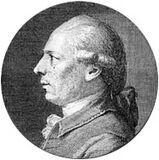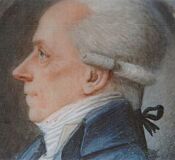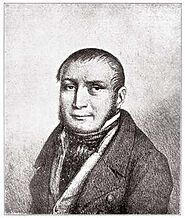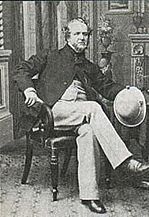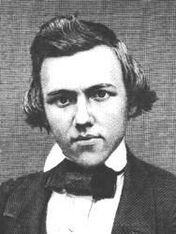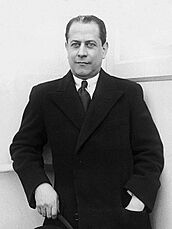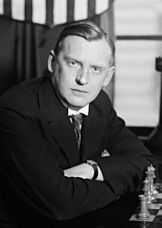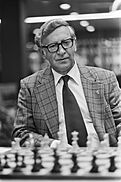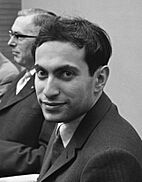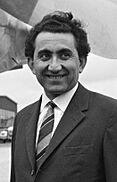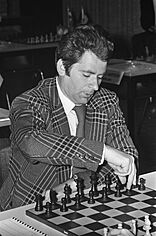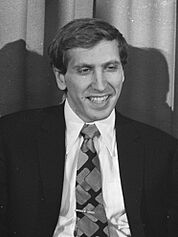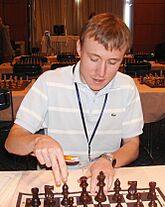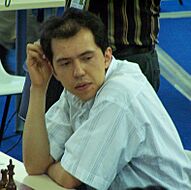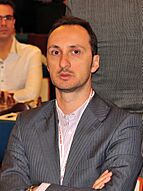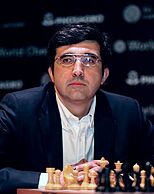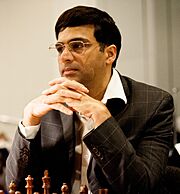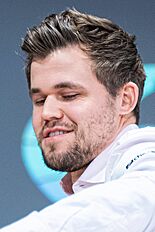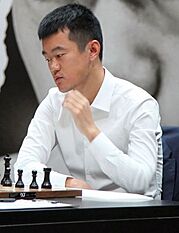World Chess Championship facts for kids
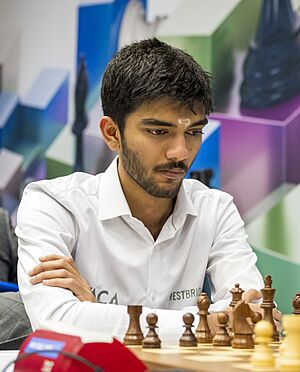
The World Chess Championship is a special competition to find the best chess player on Earth. The current world champion is Gukesh Dommaraju from India. He won the title in the 2024 World Chess Championship by beating Ding Liren.
The first event officially called a world championship was in 1886. Wilhelm Steinitz won this match against Johannes Zukertort, becoming the first world champion. For many years, the champion decided how and when they would defend their title. A challenger had to gather a lot of money to play against them.
After the champion Alexander Alekhine passed away in 1946, a group called the International Chess Federation (FIDE) took over. FIDE started organizing the championship in 1948. From then until 1993, FIDE held tournaments to pick a challenger every three years.
In 1993, the champion Garry Kasparov and his challenger Nigel Short decided to leave FIDE. They created their own group, the Professional Chess Association (PCA), to hold their match. This meant there were two world champions for 13 years! FIDE had its own champion, Anatoly Karpov. The titles finally came back together in 2006. Since 2014, the championship happens every two years. Some matches were delayed due to the COVID-19 pandemic.
Emanuel Lasker held the world champion title for 27 years, which is the longest time ever. He also won the most championships, tied with Kasparov and Karpov, with six wins each. While the main championship is open to everyone, there are also special championships for women, young players (under 20), and older players. There are also championships for different types of chess, like fast chess and super-fast chess.
Contents
History of Chess Champions
Early Chess Masters (Before 1886)
The First Strong Players
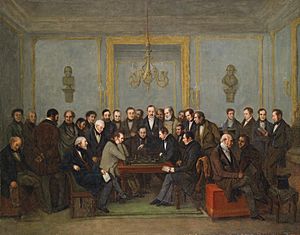
Modern chess started in Spain in the 1400s. But the rules were not always the same until the late 1800s. Before 1886, no one was officially called "world champion." Chess writers sometimes used the phrase for the best players of their time. Some historians even look back and call players from the 1600s, like Gioachino Greco, "the best."
In 1764, a book said that François-André Danican Philidor was "supposed to be the best Chess-player in the world." Philidor wrote a very popular chess book. He also showed off his amazing skill by playing chess blindfolded. However, some players at the time didn't fully agree with his ideas.
In the early 1800s, Alexandre Deschapelles from France was seen as the strongest player. Later, Louis de la Bourdonnais in France and Alexander McDonnell in Britain became the top players. La Bourdonnais visited England in 1825 and beat many English masters. He and McDonnell played a long series of matches in 1834. These games were the first to be properly recorded. La Bourdonnais won most of them.
After La Bourdonnais passed away in 1840, Howard Staunton from England became known as the strongest player. He won a match against Pierre Charles Fournier de Saint-Amant in 1843. The term "World Champion" was first used in 1845 to describe Staunton.
Top Players from 1851 to 1886
A big event was the London 1851 chess tournament, the first international chess competition. Adolf Anderssen from Germany won it easily. This made him the leading player. Some people later called him the first world champion. However, Anderssen lost a match to Tassilo von der Lasa in 1851. Von der Lasa was also considered one of the best players.
Anderssen was then beaten by Paul Morphy from America in 1858. Morphy played against many top players in 1858-59 and won every match. People at the time called him the world champion. But Morphy suddenly stopped playing chess in 1859, even though he was at his best. He was known as "the pride and sorrow of chess."
After Morphy retired, Anderssen was again seen as the strongest active player. He won another big tournament in London in 1862.
In 1866, Wilhelm Steinitz narrowly beat Anderssen in a match. Steinitz then showed he was the world's leading player by winning the London 1872 tournament. He also won a match against Johannes Zukertort in 1872.
Steinitz did not play much competitive chess between 1873 and 1882. During this time, Zukertort became the top active player. He won the London 1883 tournament, with Steinitz coming in second. This showed that Steinitz and Zukertort were the two best players. This led to their match in 1886, which Steinitz won.
There is some discussion about when Steinitz officially became world champion. Some say it was in 1866 when he beat Anderssen. Others say it was in 1886 when he beat Zukertort in the first agreed-upon world championship match. Many today say his reign was "unofficial" from 1866 to 1886, and "official" after 1886.
Champions Before FIDE (1886–1946)
Wilhelm Steinitz's Time (1886–1894)
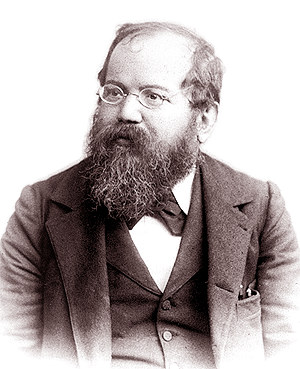
After the Steinitz–Zukertort match, it became a tradition for the world champion to play a challenger. If a player felt strong enough, they would find money to challenge the champion. If they won, they became the new champion.
Steinitz successfully defended his title several times. He beat Mikhail Chigorin in 1889 and 1892, and Isidor Gunsberg in 1891.
In the late 1880s and early 1890s, two strong young players appeared: Siegbert Tarrasch and Emanuel Lasker. Lasker was able to get the money needed to challenge Steinitz. Lasker won their 1894 match and became the new world champion.
Emanuel Lasker's Long Reign (1894–1921)

Lasker held the title for 27 years, which is still the longest time any champion has held it. He won a rematch against Steinitz in 1897. He then didn't defend his title for ten years. After that, he played four title matches in four years. He easily beat Frank Marshall in 1907 and Siegbert Tarrasch in 1908. In 1910, he almost lost to Carl Schlechter in a very close match. He then easily defeated Dawid Janowski later in 1910.
Lasker's talks for title matches after 1911 were often difficult. In 1911, he was challenged by José Raúl Capablanca. Lasker asked for a lot of money and some unusual rules. Capablanca didn't like one of the rules, and Lasker stopped the talks.
Later, in 1920, Lasker gave up his title to Capablanca because of public criticism. Some people wondered if Lasker had the right to choose his successor. Capablanca argued that if the champion gave up the title, it should go to the challenger. Lasker later agreed to play a match against Capablanca in 1921. Capablanca won their 1921 match without losing a single game.
Capablanca, Alekhine, and Euwe (1921–1946)
After his match with Lasker, Capablanca suggested new rules for future championship matches. These "London Rules" were agreed upon by other top players. They said the champion had to defend their title every year. The match would be won by the first player to win six or eight games. The prize money had to be at least $10,000 (which was a lot of money back then, about $180,000 today).
Only Alexander Alekhine was able to raise the $10,000 Capablanca asked for. They played in 1927. Most people thought Capablanca would win easily. But Alekhine surprised everyone. He had prepared very well and used his strong tactical skills. Alekhine won the match.
Alekhine then easily won two title matches against Efim Bogoljubov in 1929 and 1934. In 1935, Alekhine was unexpectedly beaten by Max Euwe from the Netherlands, who was a mathematics teacher. Alekhine won a rematch in 1937. World War II stopped any more matches, and Alekhine remained champion until he passed away in 1946.
How Matches Were Paid For
Before 1948, world championship matches were set up privately. The players, often with help from people who wanted to bet on them, would put money into a prize fund. The winner would get a larger share of this money. This system sometimes made it hard to arrange matches. For example, Akiba Rubinstein couldn't raise enough money to challenge Lasker in 1911.
Lasker started the idea that the challenger should provide all the prize money. This made it even harder for challengers. For instance, Alexander Alekhine was the only one who could raise the $10,000 Capablanca asked for in the 1920s.
FIDE Takes Over (1948–1993)
FIDE's Role and the AVRO Tournament
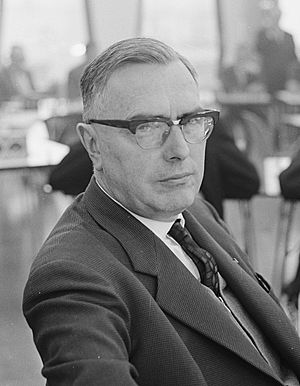
After World War I, chess players tried to create an international chess group. In 1924, FIDE was founded. FIDE wanted to help manage the world championship. They liked the "London Rules" but thought the $10,000 prize money rule was too much.
In 1937, Max Euwe suggested that if he kept his title, FIDE should manage future championship matches. FIDE had been trying to create rules for choosing challengers. The Dutch Chess Federation suggested a special tournament (called AVRO) to pick the next challenger. FIDE didn't like this idea at first. But then World War II started, and the discussion stopped.
FIDE's First Official Championship (1946–1948)
Alexander Alekhine passed away in 1946 while still champion. This meant there was no clear champion. Many people had different ideas on how to fix this. It was hard for FIDE to organize talks because of money and travel problems after World War II.
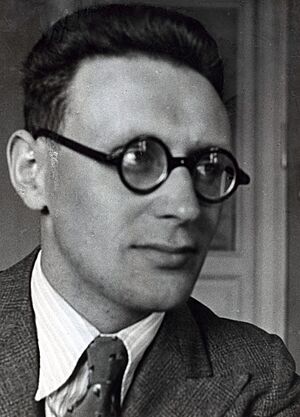
Finally, FIDE decided to use the 1938 AVRO tournament as a guide. This tournament had the eight best players in the world at the time. Two of them, Alekhine and Capablanca, had passed away. FIDE decided that the championship would go to the winner of a tournament with the other six players. These players were Max Euwe, Mikhail Botvinnik, Paul Keres, Salo Flohr, Reuben Fine, and Samuel Reshevsky. However, Flohr was replaced by Vasily Smyslov, and Fine dropped out. So, only five players competed. Botvinnik won easily and became the world champion.
FIDE also set up a new system for choosing challengers every three years:
- Zonal tournaments: Regional tournaments to qualify for the next stage.
- Interzonal Tournament: Players from the Zonal tournaments would play here.
- Candidates Tournament: The top players from the Interzonal would play here, along with the loser of the previous championship match. The winner of the Candidates would challenge the champion.
- Championship Match: The winner of the Candidates would play against the current world champion.
FIDE System in Action (1949–1963)
The FIDE system worked for five cycles. In 1956, FIDE added a rule: a defeated champion could have a rematch. This meant Mikhail Botvinnik lost to Vasily Smyslov in 1957 but won the rematch in 1958. He also lost to Mikhail Tal in 1960 but won the rematch in 1961. So, Smyslov and Tal were champions for a short time, but Botvinnik was champion for most of the period from 1948 to 1963. The rematch rule was removed for the 1963 cycle. Tigran Petrosian won the Candidates tournament in 1962 and then beat Botvinnik in 1963 to become world champion.
FIDE System (1963–1975)
After the 1962 Candidates, Bobby Fischer claimed that Soviet players were working together to stop non-Soviet players from winning. FIDE changed the Candidates Tournament format to prevent this. They switched from a round-robin tournament to a series of elimination matches. Fischer refused to play in some cycles. Boris Spassky won the Candidates twice, losing to Petrosian in 1966 but winning and becoming world champion in 1969.
In the 1969–1972 cycle, Fischer caused more issues. He refused to play in a qualifying tournament. FIDE's president, Max Euwe, bent the rules to let Fischer play. Fischer then easily won his way to challenge the champion, Boris Spassky. Their match in 1972 was very famous. Fischer had many demands, especially about money. After a lot of drama, Fischer won the match.
This meant there had been a clear line of FIDE champions from 1948 to 1972. But this ended when Anatoly Karpov won the right to challenge Fischer in 1975. Fischer didn't like the match format. He wanted to win by being the first to get 10 wins, not by playing a set number of games. He also wanted to stay champion if the score was tied 9-9. FIDE didn't agree to his demands. So, FIDE removed Fischer as champion and made Karpov the new champion. Fischer believed he was still the champion. He stopped playing chess in public until 1992, when he played an unofficial rematch against Spassky.
Karpov and Kasparov (1975–1993)
- Further information: World Chess Championship 1978, World Chess Championship 1981, World Chess Championship 1984, World Chess Championship 1985, World Chess Championship 1986, World Chess Championship 1987, and World Chess Championship 1990
After becoming champion without playing a match, Anatoly Karpov proved he deserved the title by winning many tournaments. He defended his title twice against Viktor Korchnoi in 1978 and 1981. In the 1984 World Chess Championship, Karpov played against Garry Kasparov. This match lasted over five months! Karpov was leading when the match was stopped.
Karpov finally lost his title in 1985 to Kasparov. Kasparov won by a score of 13–11. They played three more championship matches. Kasparov won in 1986 and 1990, and kept his title in 1987 when their match was a tie. These two players played 144 World Championship games against each other.
The Split Title Era (1993–2006)
In 1993, Nigel Short earned the right to challenge Kasparov. But before the match, Kasparov and Short complained that FIDE was not handling the prize money well. They decided to leave FIDE and create their own group, the Professional Chess Association (PCA). They held their match under the PCA. FIDE then took away Kasparov's title and held its own championship match between Karpov and Jan Timman. This meant that for the first time, there were two World Chess Champions. Kasparov beat Short, and Karpov beat Timman.
Both FIDE and the PCA held their own championship cycles. Kasparov won the PCA cycle, beating Viswanathan Anand in 1995. Karpov won the FIDE cycle, beating Gata Kamsky in 1996. They tried to arrange a match to bring the titles back together, but it didn't happen.
The PCA group later closed down. Kasparov then had no organization to pick his next challenger. He tried to set up matches, but they often fell apart. In 2000, Kasparov played a match against Vladimir Kramnik. Kramnik caused a big surprise by winning the match without losing a single game. Kramnik called himself the Classical World Chess Champion.
Meanwhile, FIDE changed its championship system. They started holding big knockout tournaments where many players played short matches. Fast chess games were used to break ties. Some people felt this system didn't always find the best player. Kasparov and Kramnik refused to play in these events. Karpov defended his FIDE title in 1998 but then gave it up in protest in 1999. Other players won the FIDE title: Alexander Khalifman in 1999, Anand in 2000, Ruslan Ponomariov in 2002, and Rustam Kasimdzhanov in 2004.
By 2002, there were two champions, and Kasparov was still the top-rated player. This made things even more confusing. In 2002, a plan called the "Prague Agreement" was made to reunite the titles. But it was hard to find money and organize the matches. The Kramnik–Leko match happened in late 2004 (it was a tie, so Kramnik kept his title).
FIDE never managed to organize a match for Kasparov. Kasparov became frustrated and decided to retire from chess in 2005, still ranked number one. Soon after, FIDE changed its system again. They held the FIDE World Chess Championship 2005, an eight-player tournament. Kramnik refused to play because he believed the title should be decided by a match. Veselin Topalov won this tournament. Then, talks began for a match between Kramnik and Topalov to unite the titles.
The Reunified Title (Since 2006)
Kramnik's Short Reign (2006–2007)
- Further information: World Chess Championship 2006
The World Chess Championship 2006 match between Topalov and Kramnik was held to reunite the titles. After some arguments, Kramnik won. This made Kramnik the first undisputed World Chess Champion since Kasparov left FIDE in 1993. FIDE has managed all championship matches since then.
Anand's Era (2007–2013)
- Further information: World Chess Championship 2007, World Chess Championship 2009, and World Chess Championship 2011
Kramnik defended his title at the World Chess Championship 2007 in Mexico. This was an 8-player tournament, like the one in 2005. Viswanathan Anand won this tournament, becoming the World Chess Champion. Some people questioned if winning a tournament made him a true champion, but Anand later proved himself in matches.
The next two championships had special rules. Kramnik got a chance to challenge Anand in the World Chess Championship 2008, but Anand won again. Then Topalov, who lost the 2006 match, was given a direct spot in the Candidates final for the World Chess Championship 2010. He won the Candidates and played Anand, who won the championship match again. For the World Chess Championship 2012, the Candidates Tournament used short knockout matches. This format was not popular with everyone. Anand won the championship match again in tie-break games.
Carlsen's Dominance (2013–2023)
- Further information: World Chess Championship 2013, World Chess Championship 2014, World Chess Championship 2016, World Chess Championship 2018, and World Chess Championship 2021
Since 2013, the Candidates Tournament has been an eight-player tournament where everyone plays each other twice. The winner then plays a match against the champion. Magnus Carlsen from Norway won the 2013 Candidates and then easily beat Anand in the World Chess Championship 2013.
Since 2014, the World Championship has followed a 2-year cycle. Carlsen successfully defended his title multiple times: against Anand in 2014, against Sergey Karjakin in 2016, and against Fabiano Caruana in 2018. The 2016 and 2018 matches were decided by fast tie-break games.
The COVID-19 pandemic caused delays, and the 2020 match was moved to 2021. Carlsen again defended his title, beating Ian Nepomniachtchi in the World Chess Championship 2021.
Ding Liren's Championship (2023–2024)
- Further information: World Chess Championship 2023
After the 2021 match, Carlsen said he might not defend his title again. FIDE confirmed this in July 2022. Because Carlsen chose not to play, the top two players from the Candidates Tournament, Ian Nepomniachtchi and Ding Liren, played for the title in Astana, Kazakhstan, in April 2023. Ding won in rapid tie-breaks, becoming the first World Chess Champion from China. FIDE called Ding the "17th World Champion," which means they now officially recognize the "Classical" champions from the split era.
Gukesh Dommaraju's Victory (2024–present)
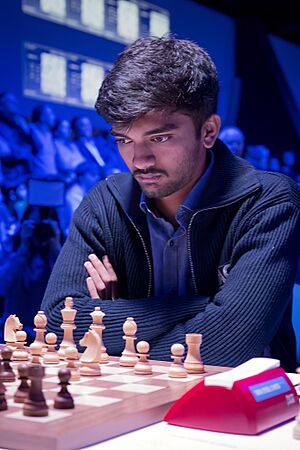
The most recent world championship was held in 2024, from November 25 to December 12 in Singapore. Ding Liren lost his title to Gukesh Dommaraju. Gukesh won the match 7½ to 6½. The players were tied going into the final game. At just 18 years old, Gukesh became the youngest undisputed World Chess Champion ever.
How the Championship Works
Before 1948, world championship matches were set up privately by the players. This often caused problems with money and agreements. There were attempts to create rules, but they didn't work well.
After the champion Alexander Alekhine passed away in 1946, the World Chess Championship 1948 was a special tournament to find a new champion.
Since 1948, the world championship usually follows a two or three-year plan with four main steps:
- Zonal tournaments: These are regional tournaments where players qualify for the next stage.
- Candidates qualification tournaments: These events help pick players for the Candidates Tournament. Examples include the Chess World Cup and the Grand Swiss. Some top players also qualify directly.
- The Candidates Tournament: This tournament chooses the challenger. It has changed in size and format over the years. Since 2013, it has been an eight-player tournament where everyone plays each other twice.
- The championship match: This is the final match between the current champion and the challenger.
There have been a few times when the system changed:
- In 1957 and 1960, the champion could get a rematch if they lost.
- The 1975 championship was not played because the champion, Fischer, refused to defend his title. The challenger, Karpov, became champion.
- Between 1993 and 2006, the world title was split, and different formats were used.
- A special match was held in 2006 to reunite the titles.
- The 2007 championship was a tournament, not a match.
- The 2023 championship was played between the top two players from the Candidates, because the champion, Carlsen, chose not to defend his title.
World Champions List
Champions Before FIDE (1886–1946)
| # | Name | Country | Years | |
|---|---|---|---|---|
| 1 | Wilhelm Steinitz | 1886–1894 | ||
| 2 | Emanuel Lasker | 1894–1921 | ||
| 3 | José Raúl Capablanca | 1921–1927 | ||
| 4 | Alexander Alekhine | 1927–1935 | ||
| 5 | Max Euwe | 1935–1937 | ||
| (4) | Alexander Alekhine | 1937–1946 | ||
| No Champion | ||||
FIDE World Champions (1948–1993)
| # | Name | Country | Years |
|---|---|---|---|
| 6 | Mikhail Botvinnik | 1948–1957 | |
| 7 | Vasily Smyslov | 1957–1958 | |
| (6) | Mikhail Botvinnik | 1958–1960 | |
| 8 | Mikhail Tal | 1960–1961 | |
| (6) | Mikhail Botvinnik | 1961–1963 | |
| 9 | Tigran Petrosian | 1963–1969 | |
| 10 | Boris Spassky | 1969–1972 | |
| 11 | Bobby Fischer | 1972–1975 | |
| 12 | Anatoly Karpov | 1975–1985 | |
| 13 | Garry Kasparov | 1985–1993 | |
Classical (PCA/Braingames) World Champions (1993–2006)
| # | Name | Country | Years |
|---|---|---|---|
| 13 | Garry Kasparov | 1993–2000 | |
| 14 | Vladimir Kramnik | 2000–2006 |
FIDE World Champions (1993–2006)
| Name | Country | Years |
|---|---|---|
| Anatoly Karpov | 1993–1999 | |
| Alexander Khalifman | 1999–2000 | |
| Viswanathan Anand | 2000–2002 | |
| Ruslan Ponomariov | 2002–2004 | |
| Rustam Kasimdzhanov | 2004–2005 | |
| Veselin Topalov | 2005–2006 |
FIDE (Reunified) World Champions (2006–Present)
| # | Name | Country | Years |
|---|---|---|---|
| 14 | Vladimir Kramnik | 2006–2007 | |
| 15 | Viswanathan Anand | 2007–2013 | |
| 16 | Magnus Carlsen | 2013–2023 | |
| 17 | Ding Liren | 2023–2024 | |
| 18 | Gukesh Dommaraju | 2024–present |
World Champions by Number of Wins
This table shows the world champions based on how many times they won a championship match. A successful defense of the title also counts as a win. If players have the same number of total wins, we look at undisputed wins, then years as undisputed champion, then total years as champion. If still tied, they are listed by the year they first won.
| Champion | Number of Wins | Years as | ||||
|---|---|---|---|---|---|---|
| Total | Undisputed | FIDE | Classical | Champion | Undisputed Champion |
|
| 6 | 6 | 27 | 27 | |||
| 6 | 4 | 2 | 15 | 8 | ||
| 6 | 3 | 3 | 16 | 10 | ||
| 5 | 5 | 13 | 13 | |||
| 5 | 5 | 10 | 10 | |||
| 5 | 4 | 1 | 8 | 6 | ||
| 4 | 4 | 17 | 17 | |||
| 4 | 4 | 8 | 8 | |||
| 3 | 1 | 2 | 7 | 1 | ||
| 2 | 2 | 6 | 6 | |||
| 1 | 1 | 6 | 6 | |||
| 1 | 1 | 3 | 3 | |||
| 1 | 1 | 3 | 3 | |||
| 1 | 1 | 2 | 2 | |||
| 1 | 1 | 1 | 1 | |||
| 1 | 1 | 1 | 1 | |||
| 1 | 1 | 1 | 1 | |||
| 1 | 1 | 0 | 0 | |||
| 1 | 1 | 2 | 0 | |||
| 1 | 1 | 1 | 0 | |||
| 1 | 1 | 1 | 0 | |||
| 1 | 1 | 1 | 0 | |||
Other Chess Championships
There are also world championships for specific groups or types of chess:
- Women's World Chess Championship
- World Junior Chess Championship (for players under 20)
- World Youth Chess Championship (for younger age groups)
- World Senior Chess Championship (for older players)
- World Amateur Chess Championship
Different time limits:
- World Rapid Chess Championship (faster games)
- World Blitz Chess Championship (very fast games)
- World Correspondence Chess Championship (games played by mail or online over a long time)
Team events:
- Chess Olympiad (teams from different countries compete)
Computer chess:
- World Computer Chess Championship (computers playing chess)
Chess problems:
- World Chess Solving Championship (solving chess puzzles)
Chess variations:
- World Chess960 Championship (also known as Fischer random chess, where the starting position of pieces is random)
See also
 In Spanish: Campeonato Mundial de Ajedrez para niños
In Spanish: Campeonato Mundial de Ajedrez para niños
- Comparison of top chess players throughout history
- List of world championships in mind sports


